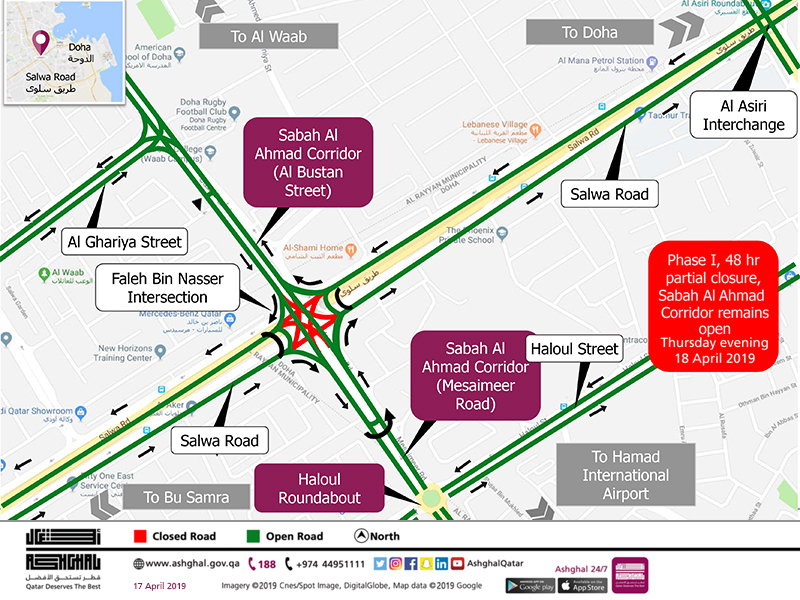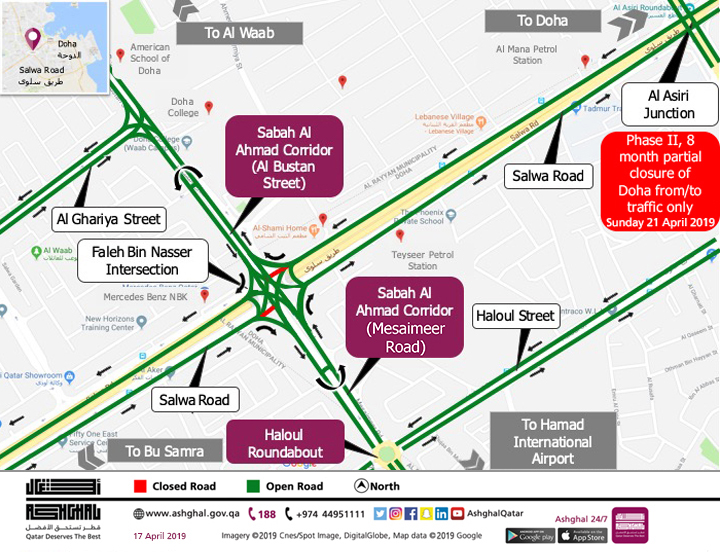The Public Works Authority ‘Ashghal’ has started the construction of the first Cable-Stayed Bridge in Qatar and the conversion of Haloul Roundabout into a two-level interchange on Sabah Al-Ahmad Corridor project.
The 1,200-meter long new bridge extends prior to Haloul Roundabout through Faleh Bin Nasser intersection in Salwa Road to provide free traffic flow between Hamad International Airport and the areas of Bu Hamour, Mesaimeer and Al Waab. The new bridge will consist of four lanes in each direction to accommodate more than 16,000 vehicles per hour.
Challenges:
Due to the length of the bridge, construction work will require the use of 854 precast concrete pieces, each weighing about 200 tons of reinforced concrete and 20 pylons and 16 piers to reach the highest point of the bridge to 30 metres high.
Haloul Interchange
Halul Roundabout will be revamped into a two-level interchange, which will include at-grade signalized intersection along with the free flow Cable-Stayed Bridge.
With the completion, the signalized intersection will consist of (6) lanes in each direction, including two right turns to the left and one for U-turn. The intersection will help the traffic in all directions to connect Sabah Al Ahmad Corridor to Halul Street and Salwa Road. It will serve Bu hamour and Al Mamoora and many vital facilities surrounding the Wholesale Market and commercial activities on Salwa Road.
Engineer Abdullah Al Naiemi said that Ashghal has already started construction of the first Cable-Stayed bridge in Qatar, which was designed in a unique way to provide a free traffic flow without the need to pass through roundabouts or light signals, especially that the bridge will pass over Halul intersection as well as Faleh Bin Nasser intersection on Salwa Road, which will ease the congestion in the vital area significantly.
He explained that the bridge over Faleh Bin Nasser intersection on Salwa Road will be without pylons at all for a distance of 150 meters, but there will be cables to bear the bridge, pointing out that the completion of the bridge will be the first quarter of 2021, as well as the completion of Halul Intersection works 2020
Traffic Diversion on Faleh Bin Nasser at-grade Intersection
Stage 1
To facilitate the works, Ashghal announces a partial closure of Faleh Bin Nasser Intersection on Salwa Road, while maintaining traffic movement through Sabah Al Ahmad Corridor and right turns open, starting Thursday night of 18th April 2019 for 48 hours to enable construction works of the cable-stayed bridge on Sabah Al Ahmad Corridor. Road users heading and coming from Doha can take right turn at Faleh Bin Nasser Intersection then make a U-turn at around 250 meters then turn right to get back on Salwa Road. Road users coming from Mesaimeer Road towards Bu Samra and from Sabah Al Ahmad Corridor towards Doha will be required to continue straight through Faleh Bin Nasser Intersection for 250 meters then turn right to get back on Salwa Road.

Stage 2
The Public Works Authority ‘Ashghal’ announces a partial closure of Faleh Bin Nasser Interchange at-grade for traffic on Salwa Road, starting Sunday morning 21 April 2019 for 8 months to enable construction works of the bridge on Sabah Al Ahmad Corridor.
During this partial closure which is designed in coordination with the General Directorate of traffic, road users will be required to use alternative routes.

Traffic on Salwa Road heading and coming from Doha can take right turn at Faleh bin Nasser Interchange then do U-turn at around 250 meters then turn right to get back on Salwa Road.
The Public works Authority will install road signs advising motorists of the traffic change. Ashghal requests all road users to abide by the speed limit and follow the road signs to ensure their safety.
Sabah Al Ahmad Corridor
For its part, Ashghal has put up the new signage for Sabah Al Ahmad Corridor across areas, carrying a special writing rather than other roads.
Ashghal has announced the completion on parts of Sabah Al Ahmad Corridor such as Al Watiyatt Interchange as well as Al Rayyan Tunnel, which is considered the longest, deepest bi-directional bridge in Qatar.
His Excellency Sheikh Abdullah bin Nasser bin Khalifa Al Thani, Prime Minister and Minister of Interior and His Highness Sheikh Nasser Al Mohammad Al Ahmad Al Sabah, Representative of His Highness Sheikh Sabah Al Ahmad Al Jaber Al Sabah, Emir of Kuwait, had launched Sabah Al Ahmad Corridor project on 24 February 2019, in the presence of a number of ministers, members of Kuwaiti delegation,diplomatic representatives and senior officials as well as representatives from the project contractors were also present in the ceremony.
Sabah Al Ahmad Corridor is the first in Qatar to be called the "Corridor" instead of a road due to its great importance and specifications of its unique construction, with the completion of the new Corridor in 2021 with a length of 25 kilometers and a total works of 37 kilometers, the road will have the first Cable-Stayed Bridge in Qatar as well as the largest intersection, longest bridge, deepest and longest bi-directional tunnel.
The road will increase the importance of the Corridor that will include the upgrade of seven (7) main roads to become not only the "Doha traffic relief" by providing an alternative route to the busy 22 February street and a double traffic capacity, but also will link another traffic from the south of the country to the north via Doha By linking the Doha Expressway with the southern part of it (Al Wakra Bypass).
Overview of Sabah Al Ahmad Corridor
Sabah Al Ahmad Corridor extends for approximately 25 kilometres from Hamad International Airport to Umm Lekhba Interchange (known as Landmark Interchange) on Doha Expressway. Its scope includes the upgrade of seven (7) main roads namely, E Ring, F Ring, Mesaimeer, Al Bustan, Bu Erayyen, Lebday and sections of Al Markhiya Street. In addition, Ashghal will enhance 12 kilometres of local and peripheral roads intersecting with the Corridor. The total road works of the project is approximately 37 kilometres.
“Delivering traffic relief in Doha”
Once completed in 2021, Sabah Al Ahmad Corridor will significantly contribute to the relief of traffic congestion on Doha Expressway in particular, 22 February Street. The new Corridor will be a vital alternative and parallel route that will serve thousands of daily commuters from the north to the south of Doha. Commuters travelling from Hamad International Airport will be able to reach Umm Lekhba Intersection in approximately 18 minutes compared to the current 50 minutes via Doha Expressway and 22 February Street reducing traffic time by 70%.
The new Corridor will also form a vital link between the north and the south through Al Doha. This interchange will also create a vital connection between Doha Expressway and Southern Part of Doha Express Highway (Al Wakra Bypass) as well as to Mesaieed Road through Al Watiyyat Interchange at F-Ring Road, which will constitute a key point to accommodate traffic to Doha Expressway and Sabah Al Ahmad Corridor.
This significant improvement in traffic will be achieved by increasing the capacity of the road to 20,000 vehicles per hour in both directions, after the current expansion to four (4) and five (5) lanes in each direction rather than three (3) or two (2) lanes in each direction. While Doha Expressway currently accommodates 12,000 vehicles per hour in both direction.
The project will convert all roundabouts to more efficient and safer signalised junctions as well as build and upgrade 17 interchanges. These interchanges will deliver 32 bridges and 12 vehicular underpasses to enhance connectivity and provide smooth traffic movements.
As part of the project’s scope of works is, a 12 pedestrian and cycle paths with a length 65 kilometres of along with 1.5 million square metre of landscaping.
Record achievements
First Cable-Stayed Bridge in Qatar
Sabah Al Ahmed Corridor includes the first Cable-Stayed Bridge in Qatar with a length of 1200 metres. It extends from Mesaimeer Road to Al Bustan Street and crosses over Halul Intersection on Mesaimeer Road and Faleh Bin Nasser Intersection on Salwa Road.
Longest Bridge
The Corridor will be the home to the longest flyover in the country, which spans 2.6 kilometres extending from Al Bustan Street to Bu Erayyen Street and crossing over Al Waab Street and Rasheeda Street.
Largest Interchange
Sabah Al Ahmad Corridor will include the largest Interchange in Qatar. The impressively complex Umm Lekhba (Landmark) Interchange has nine (9) bridges providing a free traffic flow in all directions highlighting its significance as a key access point on Doha Expressway for local residential areas and malls.
Longest and deepest bi-directional tunnel
The project consists of the recently opened Al Rayyan Road, which is the longest and deepest bi-directional tunnel in Qatar. It sits 25 metres below ground level and extends for 2.1 kilometres connecting Bu Erayyen Street and Lebday Street.
Residential Areas and Main Roads
The new Corridor is a major link facilitating connections to 15 main roads namely Al Wakra Road, Ras Bu Abboud Road, E Ring Road, F Ring Road, Industrial Road, Salwa Road, Al Rayyan Road, Al Waab Street, Al Luqta Street, Al Markhiya Street, Doha Highway and Khalifa Avenue. It will serve 25 densely populated residential areas such as Al-Thumama, Al Nuaija, Bu Hamour, Al Waab, Al Rayyan, Al Luqta, Al Gharrafa, etc.
World Cup Stadiums
Sabah Al Ahmad Corridor will facilitate access to most of the World Cup FIFA 2022 stadiums including Ras Bu Abboud, Al Thumama, Al Wakra, Khalifa International and Qatar Foundation Stadiums.
Qatar Rail
The Corridor provides easy access to some of Doha Metro stations such as the Economic Zone, Al Waab and Old Rayyan.